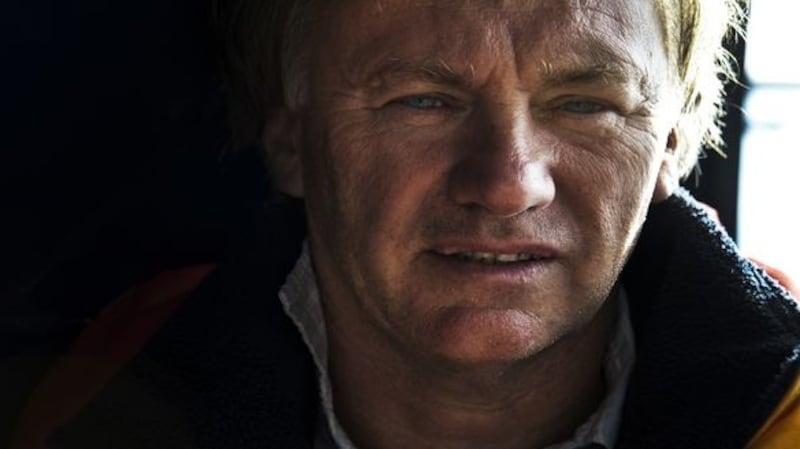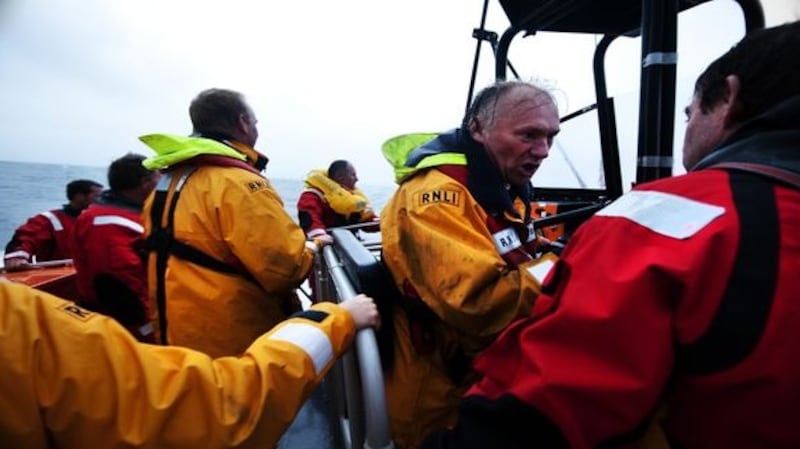Tributes have been paid to one of the country's longest serving RNLI volunteers who is stepping down after almost half a century of life saving including a dramatic rescue of former taoiseach Charles Haughey.
Kieran Cotter (65) has finally hung up his souwester after 45 years with one of the busiest lifeboats in the country, the Baltimore RNLI. During this time he has risen from volunteer crew member to coxwain, a post he has held for the last 30 years.
RNLI's Lifesaving Lead Ireland, Owen Medland, led the tributes to Cotter who joined Baltimore RNLI as a 19-year-old crew member in 1975, before serving as second cox to Christy Collins and later taking over as cox in 1989.
“It is true to say that the RNLI is built upon its people. And in Kieran the team in Baltimore have had firm foundations . . . Kieran has a remarkable record of life saving service and community commitment,” he said
“As with every volunteer this service would not have been possible without the support of family and we are equally grateful for this support which has enabled Kieran to serve his community so well.
“Kieran has left a legacy of lives saved from the sea and witnessed the evolution of the RNLI’s service provision in the area over five decades for which he should be justifiably proud. Thank you, Kieran Cotter.”
Natural leader
Baltimore RNLI also paid tribute, with chairman Declan Tiernan noting Cotter's great leadership – including his ability to assess a situation and come up with a plan which the crew execute because of their confidence in his ability.
“Natural leadership is a rare gift which Kieran Cotter has in abundance. It is the ability to instil confidence and trust in the people around you, calmly dealing with new and unforeseen circumstances without raising your voice.
“Kieran Cotter gave 45 years of service to the Baltimore Lifeboat. And when you think that in 2019 we celebrated the centenary of the first lifeboat arriving in Baltimore, it really puts Kieran’s service into perspective.”
Tiernan noted that Cotter has won several awards for gallantry in the course of his career with Baltimore RNLI which has seen him involved in numerous rescues off the southwest coast of Ireland
“Most notably, in 1991 Kieran was awarded the bronze medal for gallantry and the Maud Smith award for the bravest act of life saving that year following the 26-hour rescue of the fishing vessel, the Japonica and her 15 crew,” he said.

Cotter told The Irish Times that his late father, also Kieran, had become involved with Baltimore RNLI when the family moved from Cape Clear to the mainland in 1970 and he simply followed in his father’s footsteps.
“I was into boating myself, I was in the merchant navy when I joined. I’d say I was probably down the station prior to joining because we lived only about 300 yards from the station and somebody said, ‘do you want to join’.
“It was perfect because I was in the merchant navy from 1973 to 1975 and I was in college in Plymouth at the time studying and I struggled with physics and that was the end of that and I sort of packed up going to sea then.”
One of the first major rescues in which Cotter was involved in was when a summer storm blew up during the Fastnet Race in August 1979 and 24 of the 303 participating yachts had to be abandoned, five sank and 15 sailors were lost.
“This was a severe summer storm and one of the problems is that small yachts and big storms don’t go. We got the call about 10pm and headed out for the Fastnet and the wind was very strong with quite big seas,” he recalled.
"We towed a couple of yachts – the first one we towed was a yacht called Regardless owned by Ken Rohan, the builder – we took him in tow at about 1am and we reached Baltimore maybe around 7am.
“The wind was still very strong when we got back to Baltimore. There was carnage around the harbour when we came in because there were yachts going here there and everywhere, all over the place.
“We weren’t long in when we got another call to say there was another yacht in difficulty south of the Galley Head and we headed out and came upon the Marionette and we towed her back to Baltimore and got in at maybe 7pm.”
Distress call
Cotter had graduated to second cox by September 1985 when he and his comrades under cox Christy Collins responded to another distress call that a yacht was in difficulty near the Mizen Head.
“I had been at a wedding and came home to discover there had been a lifeboat call to say a boat was stuck at the Mizen. So we headed out but we couldn’t see any boat when we got there and we had no idea who was on board.
“There was an inlet on the north side of the Mizen and we discovered the boat, the Taurima II, a 52ft ketch, had gone down and there were four in the life raft and one in the dinghy and we took them aboard and headed for home.
"My brother, Liam was among our crew and he suddenly recognised one of the fellows – it was Charlie Haughey and he wished him a belated 60th birthday – he had been taoiseach but was leader of the Opposition at the time."
If the Haughey's rescue ended happily, not all missions were so successful and Cotter remembers the sad sight that greeted them when they went to search for Castletownbere trawler St Gervais in November 2000.
"The St Gervais had left Castletown with a crew of four around midnight and about an hour or so later, her EPIRB [Emergency Position Indicating Radio Beacon] went off southwest of the Old Head of Kinsale, " he recalled.
“Valentia Coastguard reckoned that she couldn’t be so far east so we traced back along the line from there to Castletown and as soon as we rounded the Mizen we could smell the diesel and see the wreckage – that was a sad one.”
While every rescue mission is carefully planned and co-ordinated, sometimes good fortune can also play a part as happened in August 2011 when Baltimore RNLI, with Cotter as cox, helped save 21 sailors from a capsized yacht.
“A good few of the lads would be into sailing and I would myself too so when I became coxswain we used to always try and fit in a training exercise out by the Fastnet during the Fastnet Race,” he explained.
“We were watching a couple of the boats when the weather freshened a bit and the boats speeded up so we missed some of them rounding the Fastnet including this big yacht, the Rambler.
“We had reached the Fastnet when we received a call to say a personal beeper had been activated and we were asked to proceed to the spot which was only 15 minutes away but visibility was poor, down to about a mile or so.
“After a while, one of the lads spotted a flashing light in the distance and we proceeded to the scene and found the crew on top of the Rambler which was capsized but there were four missing off the hull. We started to look for them.

"But the Wave Chieftain, owned by Jerry Smith, was out at the Fastnet with photographers and they found the missing four in the water and rescued them and we took the 17 off the hull so everyone was saved. It was a great result.
“We were lucky we were at the Fastnet and able to get to them fast because if we had to come from Baltimore it would have been another hour before we got out to the scene and light starting to fade and people in the water.”
New experience
While rescues and search operations have been very much the norm for Cotter over the past 45 years, July 2007 brought a new experience when Baltimore RNLI assisted gardaí in a major drug recovery operation.
“We got the call to head out to Dunlough Bay at the end of the Mizen. Castletownbere RNLI had got the call too so we both arrived at Dunlough Bay to discover a RIB [rigid inflatable boat] had capsized and its crew and cargo had gone into the sea.
“One fellow got ashore and raised the alarm before vamoosing back to the UK and a few more were caught by gardaí. But there was one chap in the water and Castletownbere rescued him and we picked up the drugs.
“We fished out 61 bales of cocaine – one 1½ tonnes of it – worth €440 million and we brought it back to Baltimore where we handed it over to gardaí. It was definitely one of the more unusual missions we were tasked with.”
Cotter is full in his praise for the RNLI and the support the organisation has given him and his fellow volunteers over the years in terms of training and equipment which has changed hugely since he joined in 1975.
"When I joined first we had a boat called Sarah Tilson. She had two 45 horsepower engines, capable of doing maybe eight knots and you didn't have any navigational equipment other than a direction finder and certainly not radar.
“You had an RT radio, you didn’t have a VHF radio and you had an open aft cockpit with kind of covering over you when you sat in there but with the water flowing across the deck there you would be cold and miserable.
"When you compare the Sarah Tilson to the Alan Massey where you can do 25 knots and you're inside a heated cabin strapped in with all this navigational equipment so you know exactly where you are, it's chalk and cheese."
Calling it a day
A busy shopkeeper right in the heart of Baltimore village, Cotter is looking forward to spending more time with his wife Brigid and their sons, Ciaran (33), Cillian (28) and their daughter Dearbhail (26).
Looking back on his 45 years in the volunteer service, Cotter said that he very much enjoyed the experience and the great camaraderie there is not just among the Baltimore Lifeboat crews but among RNLI members generally.
“I enjoyed it very much – there will always been hairy and scary times – lifeboating has risks. We often did searches close to the shore and that sort of thing but you have to be careful; and if you are, it should work out okay.
“Will I miss it? Yerrah, not really! There is a time for everything and the time for getting out of bed in two minutes is past my ability now at 65. I wouldn’t be getting out of bed and down the stairs the way I used to 40 years ago.
“At the same time, I’m maintaining my links with the service as I’m going to become deputy launching officer and I can stay at that until I’m 70 so I have another few years to offer and stay in touch with everyone in the lifeboat.












